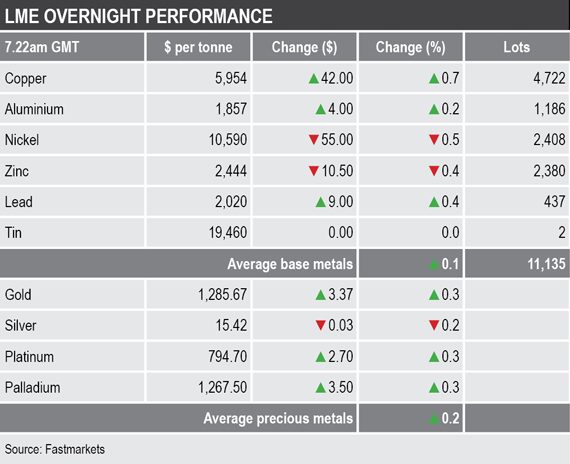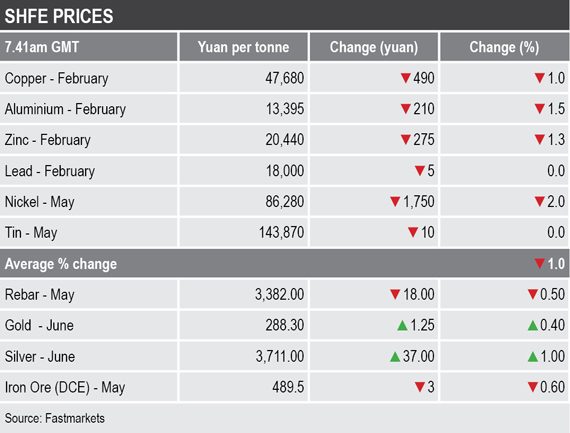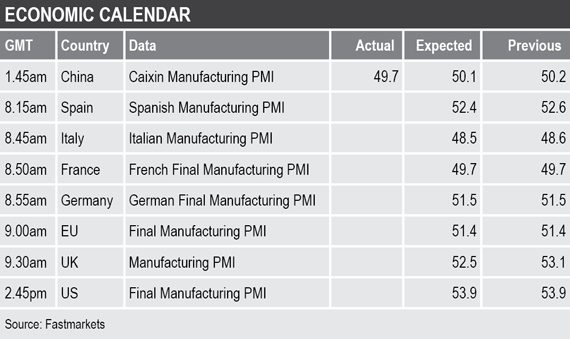Weak manufacturing purchasing managers’ index (PMI) readings showed the Chinese economy has slipped into contraction mode, which is further evidence that the trade dispute between the Asian nation and the United States is having an economic impact, along with other issues.
This morning, Wednesday January 2, three-month base metals prices on the LME were mixed; nickel and zinc were off by 0.5% and 0.4% respectively, tin was unchanged, aluminium was up by 0.2%, lead was up by 0.4% and copper was up by 0.7% at $5,954 per tonne – the recent low being $5,887.50 per tonne.
Volume across the complex has been high with 11,135 lots traded as at 7.22am London time.
Gold prices have put in a strong performance in recent days and were recently quoted at $1,285.35 per oz. Silver has followed the yellow metal’s cue and was recently quoted at $15.42 per oz, while palladium has held up in high ground and platinum prices have remained rangebound.
In China this morning, base metals prices on the Shanghai Futures Exchange were down across the board by an average of 1% – led by a 2% drop in the May nickel contract. The February copper contract was down by 1% at 47,680 yuan ($6,932) per tonne.
Spot copper prices in Changjiang were down by 0.3% at 47,870-48,080 yuan per tonne and the LME/Shanghai copper arbitrage ratio was recently at 8.02.
In wider markets, the spot Brent crude oil price was weaker, off by 1.72% at $53.21 per barrel, with the price reflecting the weaker economic data. The yield on US 10-year treasuries has weakened further, which suggests risk-off – it was recently quoted at 2.6907%. The yields on the US 2-year and 5-year treasuries have returned to normal with the 5-year higher than the 2-year, but the 2-year remains inverted against the 3-year. The German 10-year bund yield was also weaker at 0.2140%.
Asian equity markets were broadly weak on Wednesday: Hang Seng (-2.9%), Kospi (-1.52%), the CSI 300 (-1.37%) and the Australian ASX 200 (1.57%).
The dollar index has continued to ease and was recently quoted at 95.96. Out of the other major currencies we follow, the yen has been the strongest and was recently quoted at 109.31 – another sign of haven asset buying, while the euro and sterling have been edging higher at 1.1477 and 1.2750 respectively, while the Australian dollar remains in low ground at 0.7032.
The yuan is firmer at 6.8554, while the other emerging market currencies we follow are quite mixed.
On the economic agenda on Wednesday, data already out shows China’s Caixin manufacturing PMI fell to 49.7 in December, after a previous reading of 50.2. Later, there is a host of manufacturing PMI data out across Europe and the US.
Base metals prices are for the most part in the doldrums and the trends are either sideways-down or downward. The exceptions to this are lead and tin, where prices have found some support, lead driven by rises in warrant cancellation on December 21 and 24, while disrupted exports from Indonesia are underpinning tin. Given the economic outlook and continued US-China trade dispute, there is little to be bullish about in the metals, other than the general trend of falling stocks, which on their own should be supportive and could become bullish if they continue to fall.
The weakness in other markets is leading to a flow into haven assets and gold is benefiting from that, along with silver.



